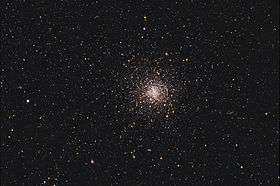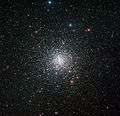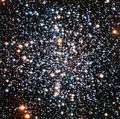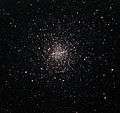Messier 4
Messier 4 or M4 (also designated NGC 6121) is a globular cluster in the constellation of Scorpius. It was discovered by Philippe Loys de Chéseaux in 1745 and catalogued by Charles Messier in 1764. It was the first globular cluster in which individual stars were resolved.
| M4 | |
|---|---|
 | |
| Observation data (J2000 epoch) | |
| Class | IX[1] |
| Constellation | Scorpius |
| Right ascension | 16h 23m 35.22s[2] |
| Declination | –26° 31′ 32.7″[2] |
| Distance | 7.2 kly (2.2 kpc) |
| Apparent magnitude (V) | +5.9[3] |
| Apparent dimensions (V) | 26′.0 |
| Physical characteristics | |
| Mass | 6.7×104[4] M☉ |
| Radius | 35 light-years |
| Metallicity | = –1.07[5] dex |
| Estimated age | (12.2 ± 0.2) Gyr[6] |
| Notable features | Closest globular cluster |
| Other designations | NGC 6121[3] |
Visibility
M4 is conspicuous in even the smallest of telescopes as a fuzzy ball of light. It appears about the same size as the Moon in the sky. It is one of the easiest globular clusters to find, being located only 1.3 degrees west of the bright star Antares, with both objects being visible in a wide-field telescope. Modestly sized telescopes will begin to resolve individual stars, of which the brightest in M4 are of apparent magnitude 10.8.
Characteristics
M4 is a rather loosely concentrated cluster of class IX and measures 75 light-years across. It features a characteristic "bar" structure across its core, visible to moderate sized telescopes. The structure consists of 11th-magnitude stars and is approximately 2.5' long and was first noted by William Herschel in 1783. At least 43 variable stars have been observed within M4.
M4 is approximately 7,200 light-years away, making it the closest globular cluster to the Solar System. It has an estimated age of 12.2 billion years.[6]
In astronomy, the abundance of elements other than hydrogen and helium is called the metallicity, and it is usually denoted by the abundance ratio of iron to hydrogen as compared to the Sun. For this cluster, the measured abundance of iron is equal to:
This value is the logarithm of the ratio of iron to hydrogen relative to the same ratio in the Sun. Thus the cluster has an abundance of iron equal to 8.5% of the iron abundance in the Sun. Based upon the abundance measurements, there is evidence that this cluster hosts two distinct stellar populations. Each of the populations is a group of stars that all formed at about the same time. Thus the cluster may have undergone at least two separate cycles of star formation.[5]
The space velocity components of this cluster are (U, V, W) = (–57 ± 3, –193 ± 22, –8 ± 5) km/s. It is following an orbit through the Milky Way that has a period of (116 ± 3) million years and an eccentricity of 0.80 ± 0.03. During periapsis it comes within (0.6 ± 0.1) kpc from the galactic core, while at apoapsis it travels out to a distance of (5.9 ± 0.3) kpc. The orbital inclination is at an angle of 23° ± 6° from the galactic plane, carrying it as much as (1.5 ± 0.4) kpc above the disk.[7] When passing through the disk, this cluster does so at distances of less than 5 kpc from the galactic nucleus. The cluster undergoes tidal shock during each passage, which can cause the repeated shedding of stars. Thus the cluster may have been much more massive in the past.[5]
Notable stars
Photographs taken with the Hubble Space Telescope in 1995 have revealed white dwarf stars in M4 that are among the oldest known stars in the Milky Way Galaxy at an age of 13 billion years. One such white dwarf has been found to be a binary star with a pulsar companion, PSR B1620−26 and a planet orbiting it with a mass of 2.5 times that of Jupiter.
In 1987 a millisecond pulsar was discovered in M4 with a period of 3.0 milliseconds, or about ten times faster than the Crab Pulsar.
CX-1 Is located in M4. It is known as a possible millisecond pulsar/neutron star binary. It orbits in 6.31 hours.
Spinthariscope
The view of Messier 4 as seen through a telescope has been described by Robert Burnham Jr. as the view of hyperkinetic luminous alpha particles as seen in a Spinthariscope (see page 1703 in Burnham's Celestial Handbook, Volume three: Pavo through Vulpecula).
Gallery
 One star in Messier 4 was also found to have much more of the rare light element lithium than expected.[8]
One star in Messier 4 was also found to have much more of the rare light element lithium than expected.[8] Messier 4 contains several tens of thousand stars and is noteworthy in being home to many white dwarfs.[9]
Messier 4 contains several tens of thousand stars and is noteworthy in being home to many white dwarfs.[9] Messier 4 as seen in 32-inch Schulman telescope
Messier 4 as seen in 32-inch Schulman telescope
References
- Shapley, Harlow; Sawyer, Helen B. (August 1927). "A Classification of Globular Clusters". Harvard College Observatory Bulletin. 849 (849): 11–14. Bibcode:1927BHarO.849...11S.
- Goldsbury, Ryan; et al. (December 2010). "The ACS Survey of Galactic Globular Clusters. X. New Determinations of Centers for 65 Clusters". The Astronomical Journal. 140 (6): 1830–1837. arXiv:1008.2755. Bibcode:2010AJ....140.1830G. doi:10.1088/0004-6256/140/6/1830.
- "M 4". SIMBAD. Centre de données astronomiques de Strasbourg. Retrieved 2010-03-25.
- Marks, Michael; Kroupa, Pavel (August 2010). "Initial conditions for globular clusters and assembly of the old globular cluster population of the Milky Way". Monthly Notices of the Royal Astronomical Society. 406 (3): 2000–2012. arXiv:1004.2255. Bibcode:2010MNRAS.406.2000M. doi:10.1111/j.1365-2966.2010.16813.x. Mass is from MPD on Table 1.
- Marino, A. F.; et al. (November 2008). "Spectroscopic and photometric evidence of two stellar populations in the Galactic globular cluster NGC 6121 (M 4)". Astronomy and Astrophysics. 490 (2): 625–640. arXiv:0808.1414. Bibcode:2008A&A...490..625M. doi:10.1051/0004-6361:200810389.
- Caputo, F.; Castellani, V.; Quarta, M. L. (February 1985). "Reddening, distance modulus and age of the globular cluster NGC 6121 (M4) from the properties of RR Lyrae variables". Astronomy and Astrophysics. 143 (1): 8–12. Bibcode:1985A&A...143....8C.
- Dinescu, Dana I.; Girard, Terrence M.; van Altena, William F. (April 1999). "Space Velocities of Globular Clusters. III. Cluster Orbits and Halo Substructure". The Astronomical Journal. 117 (4): 1792–1815. Bibcode:1999AJ....117.1792D. doi:10.1086/300807.
- "A Cluster with a Secret". ESO Press Release. Retrieved 5 September 2012.
- "Ancient orbs". ESA/Hubble Picture of the Week. Retrieved 3 September 2012.
External links
| Wikimedia Commons has media related to Messier 4. |
- M4, SEDS Messier pages
- M4, Galactic Globular Clusters Database page
- "Hubble Space Telescope Finds Stellar Graveyard". Hubble News Desk. 1995-08-28. Retrieved 2006-05-24.
- Gray, Meghan. "M4 – Globular Cluster". Deep Sky Videos. Brady Haran.
- Messier 4 on WikiSky: DSS2, SDSS, GALEX, IRAS, Hydrogen α, X-Ray, Astrophoto, Sky Map, Articles and images
